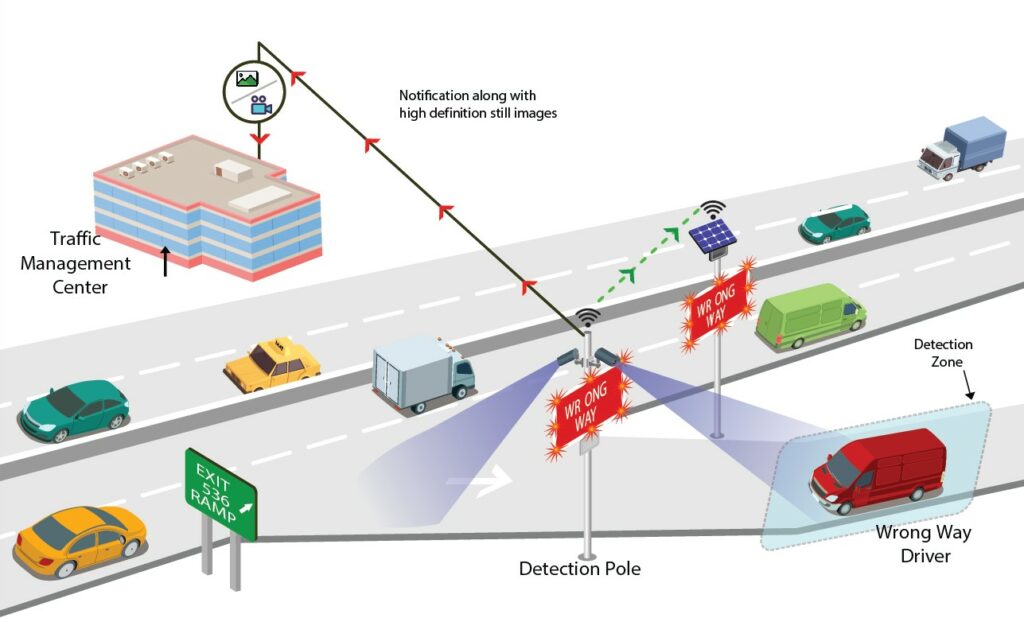
Credit – GovComm
In the US, it’s estimated that 400 people a year are killed as a result of head-on collisions from wrong-way drivers.
GovComm, an industry leading designer and developer of intelligent transportation systems, support the Vision Zero global mission to eliminate all traffic fatalities and severe injuries, while increasing safe and equitable mobility for all.
Supplying to various transportation departments, GovComm realised that limitations with optical and thermal cameras made it impossible to accurately analyse traffic scenes, not least in their lack of the resources required to collect wrong-way detection data and handle video rendering.
GovComm developed innovative wrong-way vehicle detection systems, enhanced with CPU and GPU modules, that provides high-definition detection and confirmation images of each event. The systems contain a bi-spectrum camera with thermal and high-definition optical sensors, AI software on-board powerful computer module monitors and wrong-way warning signs. The systems also send time-sensitive notifications to the local traffic management center.
Brainboxes Industrial Ethernet Switches enable connectivity throughout the systems, connecting the camera’s on-board NVIDIA computer module via Ethernet to the local traffic management center. This enables GovComm to monitor the data and determine when an event is or isn’t happening in real-time. In this case, when a vehicle is travelling the wrong way on a highway exit ramp.

Credit – GovComm
“A chain is as strong as its weakest link and if the network switch goes out there’s no connectivity, the system’s useless and you have a vehicle going the wrong way and we’re not catching it – it’s a life safety device, so it’s something we need to be extra careful about” – Craig Waltzer, Chief Executive Officer at GovComm
GovComm’s wrong-way vehicle detection systems are life safety devices that perform time sensitive video analytics at high frame rates. Their systems are also optimized to alert drivers, traffic managers and law enforcement within a fraction of a second from the detection of an event. Utilizing the network, GovComm relies on Brainbox switches in conjunction with their proprietary AI software on-board a powerful NVIDIA module for better images and analytics.
“Now we’re doing analytics at roughly 40fps and we’ve become the most accurate in our industry” – Craig Waltzer, Chief Executive Officer at GovComm
GovComm chose Brainboxes 8-port switch for their wrong-way traffic detection systems due to the wide temperature range. This is particularly vital for traffic systems in Florida, which tends to maintain warm temperatures throughout the entire year. Therefore, it’s vital that the switch doesn’t fail within the systems when subjected to high or low temperatures. If the switch couldn’t operate within these temperatures, the wrong-way traffic systems wouldn’t be able to function and this would be detrimental to road safety. The Brainbox switch has an industrial temperature range of -40°C to +80°C (-40°F to 176°F). Through environmental laboratory testing, GovComm were able to certify the SW-508 with NEMA and the Department of Transportation under the ISO 9000 standard.
“The switch just has to operate with our system and not break when it’s subjected to environmental conditions” – Craig Waltzer, Chief Executive Officer at GovComm
Brainboxes devices allow GovComm to reliably maintain safety critical systems. If the switch fails, traffic managers will not be provided with any data, causing the whole operation to stop. This could lead to missed wrong-way detections which can cause deadly consequences for drivers. The wide operating temperature range also allows the switch to be subjected to any environment and maintain its reliability as a life safety device.
-
SW-508
$132.15 Add to cart

